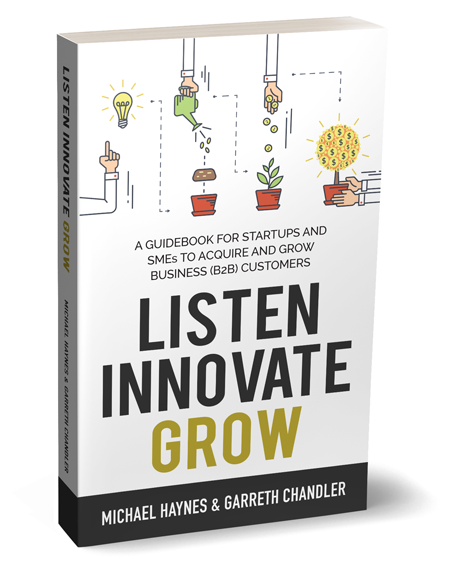As SME leaders look for ways to grow and position businesses for sustainable growth into 2021, identifying and executing a strong product development strategy is an often overlooked but critical consideration.
However, especially in our pandemic-affected times, careful attention must be paid to the components of the products being created and developed, as it can have a direct impact on how successful the strategy may be.
- What is a B2B product?
- What is a product development strategy?
- What are the components of a B2B product or service offering?
- Product development strategy examples
- How do you identify what business customers want?
- Need help to determine the right strategy for your business?
- 6 key steps in developing your B2B product and service offerings
- The link between Product Development and Go-To-Market strategy
What is a B2B product?
A B2B product can be either:
- Tangible goods, such as engineering or machining equipment.
- Professional services provided to other businesses, such as business consulting.
The end goal for any B2B product or service provider is to create value for its target markets and customers. Therefore, in order to really create value, the business must take a holistic view of the products and services it offers.
What is a product development strategy?
Often in business, we think a product development strategy is simply coming up with product ideas and taking them to market, perhaps through innovative product design and marketing.
Unfortunately, this approach does not take into consideration the needs of the market nor the business customer. But more specifically, it also excludes the needs of the business buyer.
An effective B2B product development strategy can consist of:
- Improving an existing product or service offering
- Extending product lines or
- Developing new product or service offerings
The key is that the goals, priorities and requirements of the purchase decision-makers (i.e. business buyers) AND users are considered throughout the process. From business analysis to product and service development, to testing, and marketing.
What are the components of a B2B product or service offering?
The way your SME used to package and promote your products and services prior to the pandemic may no longer be applicable. The needs of your business customers and how they buy will have changed and many of your target customers may also be hesitant to undertake any spending.
To create products and services your business customers will want to buy, in today’s environment, they must consist of the following:
1. Your core product or service:
The key function of your product or service that solves a customer’s problem or meet key priorities as they currently define them
Example of a “Core Product”
A piece of biomedical diagnostic equipment enabling scientists to conduct analyses for specific respiratory conditions.
Example of a “Core Service”
An MSP offering managed IT services, supporting geographically disparate teams across multiple time zones for its client.
However, simply providing a core product or service may not be enough to win your target customers’ business.
Your clients and prospects may also be looking at what extras you offer that may help them with direction and guidance towards achieving their own business goals.
We commonly refer to these extras as the “value-adds”.
2. Your value-adds
These value-adds may consist of additional services, programs and systems that help business customers to:
- Use your product or service and/or
- Address their most pressing concerns, priorities and challenges
Examples of value-adds that will likely be in high demand as businesses look to restart and navigate in this new business environment include:
i) Audits and analysis
Of existing systems, processes, business models, business performance
ii) Advice and consulting
On new systems, processes, strategies, business models, organizational structure, financing market opportunities to help improve sustainability, competitiveness and profitability.
iii) Joint market research
To provide business customers with insights on small business trends, customer requirements and preferences, unmet/underserved customer needs, opportunities for market and/or product expansion.
iv) Remote installation and maintenance
To support software, programs and systems that facilitate your business customers’ working across locations and markets.
v) Peer engagement and community building
Providing access to membership groups, forums or special events allowing your business customers to engage with peers, industry leaders and/ or subject-matter experts.
vi) Training
e.g. Workshops (In-person or Virtual) and Webinars
Other services that your business customers and clients may value include:
- Delivery (e.g. Curbside or Home Delivery)
- Order Management and Inventory
Therefore, when creating a product development strategy for your B2B product or service offering, it’s critical to focus on developing a comprehensive customer solution.
Product development strategy examples
There are 3 configurations that you can consider when creating “bundles” or ‘packages’ for your business clients:
A. Basic bundle configurations
Some common “package” configurations that firms will offer their business clients may include:
- Service + Analysis + Advice
- Software + Analysis + Advice
- Software + Training + Advice
B. The “Naked Solution”
In this instance, your company provides business customers with the bare minimum of products and services that all customers value. Clients are given a selection of add-on options they can choose to purchase for an additional cost.
For example, a business consulting company may provide all of its clients with its core advisory and document review services.
Clients are also given the option to purchase additional services and support they require as shown in the following diagram
Core Services
Value-Adds
C. Tiered offerings
These are solutions (or packages) comprised of your core products and value adds, constructed and priced based on the amount of perceived value they contain. Such bundles may be offered using a “Gold”, “Silver”, “Bronze” approach.
For instance, an IT company may include in their “Gold” Package: 24/7 support, service level guarantees, monthly analytics and reporting and VIP Event Invitations.
In contrast, their “Bronze” level customers, may receive customer support only Weekdays (8am-6pm) and Quarterly reporting.
You may be familiar with tiered offerings from pricing tables similar to these:
Bronze
$X
- CRM platform with lead, contact and deal management
- Sales analytics
- Phone support (M-F 8a.m.-6p.m.)
Silver
$XX
- All Bronze level features, plus:
- Advanced reporting
- Marketing activity management
Gold
$XXX
- All Silver level features, plus:
- Advanced reporting and analytics
- Premium support (24/7)
- Enterprise grade security
- Access to VIP forums
Business customer solutions have been found to be effective in a range of industries including:
- Information Technology
- Accounting
- Law
- Engineering
- Consulting
How do you identify what business customers want?
Tailoring product and service offerings to meet the requirements of your target markets and business buyers can be achieved by “listening to your market” and the business buyers and customers in them.
Listening to the market
- Industry (Face to Face or Virtual) Summits and Roundtables
- Industry and Professional Associations-reports, events
- Livestreams, Q&As held by industry experts, thought leaders
- Syndicated market research reports
- Consulting firm industry reports
Listening to business customers
- In-depth interviews/ client review sessions
- Strategic Customer Workshops
- Customer Advisory Boards
- Decision Maker Summits
- Customer Co-creation

Need help to determine the right strategy for your business?
6 key steps in developing your B2B product and service offerings
1. Business strategy development and review
Ensure new service strategies and offerings align with the larger strategic mission and vision of your organization
2. New service strategy development
Define proposed new offerings in terms of target markets and customers, types of services and required capabilities, profit criteria or other relevant factors
3. Idea generation
This can be achieved through means such as:
- Formal brainstorming sessions,
- Strategic customer workshops,
- Internal innovation teams,
- Employee surveys,
- Customer and strategic partners surveys,
- Competitor analysis
Also achieved through collaboration co-creation efforts with customers, competitors, suppliers, strategic/alliance partners, universities, start-ups
4. Service prototype development
This step should involve input from all the customers and employees potentially impacted by the new service, e.g. your marketing, client delivery, customer success and human resources teams.
During this stage, prototypes, mock-ups as well as service blueprints will be developed to design and specify the service processes
Post-sale implementation support plans should also be developed to assist clients with onboarding and use of the service offering. This increases the likelihood of success and the meeting of their key objectives. These implementation plans will include:
- Transition plan to the new service
- Product and service training
- Workflow management and procedures
5. Business analysis
Once a service offering has been developed, analyse the following:
- Economic feasibility and potential profit implications
- Demand and revenue projections
- Cost analyses
- Operational feasibility
- Investment and resource requirements
6. Market testing
Testing is undertaken to determine marketplace’s acceptance of the new offering as well as other variables such as pricing, promotion and channels. Market testing is achieved by making it available to a small sample of the target market.
If this is not feasible (for instance, your organization has only one point of delivery), the new offering should be made available to employees to gain feedback on its components.
Some best practice principles to apply to developing new or modified B2B service offerings include:
- Focus on the needs of the business buyer as well as the users
- Gain input into your proposed offerings from both current clients and prospects
- Consider and anticipate your competition
- Use cross-functional teams including participants from marketing, business development, client delivery and support
- Create a centralized database to capture all work and learnings from the developing the service offerings
- Review your offerings at least semi-annually to ensure that they meet business customer needs as well as current market trends and conditions

The link between Product Development and Go-To-Market strategy
Simply put, your “Go To Market” strategy is the way in which your company brings its product to market, in other words, your market development strategy.
It is important that your strategy meets the needs, requirements, and priorities of the specific markets and customers you are targeting. Business buyers will want confidence and assurance that they will achieve their intended outcomes from using your service solution.
Therefore, when developing your marketing strategy, you must consider these elements may need to be tailored to your different target markets and customers.
Want to get started with your Product Development Strategy but unsure how?
If you’ve identified that creating a product development strategy could help grow your business in 2021 and beyond, but feel you need a guiding hand to zero in on the service offerings your customers actually want, schedule a call with Michael for an obligation-free chat.
Alternatively, read more about our SME Coaching Program, Refocus Reignite and Rise and how we can help your company achieve its goals in the next 12 months.


